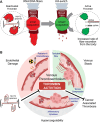Cracking the Code: Enhancing Molecular Tools for Progress in Nanobiotechnology
- PMID: 38833534
- PMCID: PMC11190997
- DOI: 10.1021/acsabm.4c00432
Cracking the Code: Enhancing Molecular Tools for Progress in Nanobiotechnology
Abstract
Nature continually refines its processes for optimal efficiency, especially within biological systems. This article explores the collaborative efforts of researchers worldwide, aiming to mimic nature's efficiency by developing smarter and more effective nanoscale technologies and biomaterials. Recent advancements highlight progress and prospects in leveraging engineered nucleic acids and proteins for specific tasks, drawing inspiration from natural functions. The focus is developing improved methods for characterizing, understanding, and reprogramming these materials to perform user-defined functions, including personalized therapeutics, targeted drug delivery approaches, engineered scaffolds, and reconfigurable nanodevices. Contributions from academia, government agencies, biotech, and medical settings offer diverse perspectives, promising a comprehensive approach to broad nanobiotechnology objectives. Encompassing topics from mRNA vaccine design to programmable protein-based nanocomputing agents, this work provides insightful perspectives on the trajectory of nanobiotechnology toward a future of enhanced biomimicry and technological innovation.
Keywords: ISRNN; RNA nanotechnology; mRNA vaccines; nanobiotechnology; nanoparticles; nucleic acid therapies.
Conflict of interest statement
The authors declare no competing financial interest.
Figures










Similar articles
-
The role of nanobiotechnology in drug discovery.Drug Discov Today. 2005 Nov 1;10(21):1435-42. doi: 10.1016/S1359-6446(05)03573-7. Drug Discov Today. 2005. PMID: 16243263 Review.
-
A review of RNA nanoparticles for drug/gene/protein delivery in advanced therapies: Current state and future prospects.Int J Biol Macromol. 2025 Mar;295:139532. doi: 10.1016/j.ijbiomac.2025.139532. Epub 2025 Jan 5. Int J Biol Macromol. 2025. PMID: 39765293 Review.
-
Programmable DNA Nanodevices for Applications in Neuroscience.ACS Chem Neurosci. 2021 Feb 3;12(3):363-377. doi: 10.1021/acschemneuro.0c00723. Epub 2021 Jan 12. ACS Chem Neurosci. 2021. PMID: 33433192
-
Prevention of microbial biofilms - the contribution of micro and nanostructured materials.Curr Med Chem. 2014;21(29):3311. doi: 10.2174/0929867321666140304101314. Curr Med Chem. 2014. PMID: 24606506
-
Nanobiotechnology-based drug delivery in brain targeting.Curr Pharm Biotechnol. 2013;14(15):1264-74. doi: 10.2174/1389201015666140608143719. Curr Pharm Biotechnol. 2013. PMID: 24910011 Review.
Cited by
-
Chemical Composition and Backbone Modifications Define Deformability of Nucleic Acid Nanoparticles.ACS Nano. 2025 Jul 15;19(27):24972-24984. doi: 10.1021/acsnano.5c04293. Epub 2025 Jul 3. ACS Nano. 2025. PMID: 40607511 Free PMC article.
-
Autonomous Nucleic Acid and Protein Nanocomputing Agents Engineered to Operate in Living Cells.ACS Nano. 2025 Jan 21;19(2):1865-1883. doi: 10.1021/acsnano.4c13663. Epub 2025 Jan 6. ACS Nano. 2025. PMID: 39760461 Free PMC article. Review.
-
Harnessing Computational Approaches for RNA-Targeted Drug Discovery.RNA Nanomed. 2024 Dec;1(1):1-15. doi: 10.59566/isrnn.2024.0101001. RNA Nanomed. 2024. PMID: 40201452 Free PMC article.
-
RNA Nanotechnology for Codelivering High-Payload Nucleoside Analogs to Cancer with a Synergetic Effect.Mol Pharm. 2024 Nov 4;21(11):5690-5702. doi: 10.1021/acs.molpharmaceut.4c00674. Epub 2024 Oct 10. Mol Pharm. 2024. PMID: 39388598
-
Nucleic acid nanobiosystems for cancer theranostics: an overview of emerging trends and challenges.Nanomedicine (Lond). 2025 Jun;20(11):1281-1298. doi: 10.1080/17435889.2025.2501919. Epub 2025 May 6. Nanomedicine (Lond). 2025. PMID: 40326805 Review.
References
-
- Ezike T. C.; Okpala U. S.; Onoja U. L.; Nwike C. P.; Ezeako E. C.; Okpara O. J.; Okoroafor C. C.; Eze S. C.; Kalu O. L.; Odoh E. C.; Nwadike U. G.; Ogbodo J. O.; Umeh B. U.; Ossai E. C.; Nwanguma B. C. Advances in drug delivery systems, challenges and future directions. Heliyon 2023, 9 (6), e1748810.1016/j.heliyon.2023.e17488. - DOI - PMC - PubMed
Publication types
MeSH terms
Substances
Grants and funding
- R35 GM134919/GM/NIGMS NIH HHS/United States
- R01 CA279810/CA/NCI NIH HHS/United States
- ZIA ES103247/ImNIH/Intramural NIH HHS/United States
- R01 GM062750/GM/NIGMS NIH HHS/United States
- R35 GM134931/GM/NIGMS NIH HHS/United States
- R21 HG011120/HG/NHGRI NIH HHS/United States
- R01 GM120923/GM/NIGMS NIH HHS/United States
- R01 CA197865/CA/NCI NIH HHS/United States
- R01 CA229869/CA/NCI NIH HHS/United States
- R01 GM077234/GM/NIGMS NIH HHS/United States
- R35 GM142788/GM/NIGMS NIH HHS/United States
- R01 EB034279/EB/NIBIB NIH HHS/United States
- R01 GM141394/GM/NIGMS NIH HHS/United States
- U01 CA207946/CA/NCI NIH HHS/United States
- R35 GM134864/GM/NIGMS NIH HHS/United States
- R01 EY031452/EY/NEI NIH HHS/United States
- R35 GM139587/GM/NIGMS NIH HHS/United States
- R01 CA257961/CA/NCI NIH HHS/United States
- P41 GM128577/GM/NIGMS NIH HHS/United States
LinkOut - more resources
Full Text Sources
